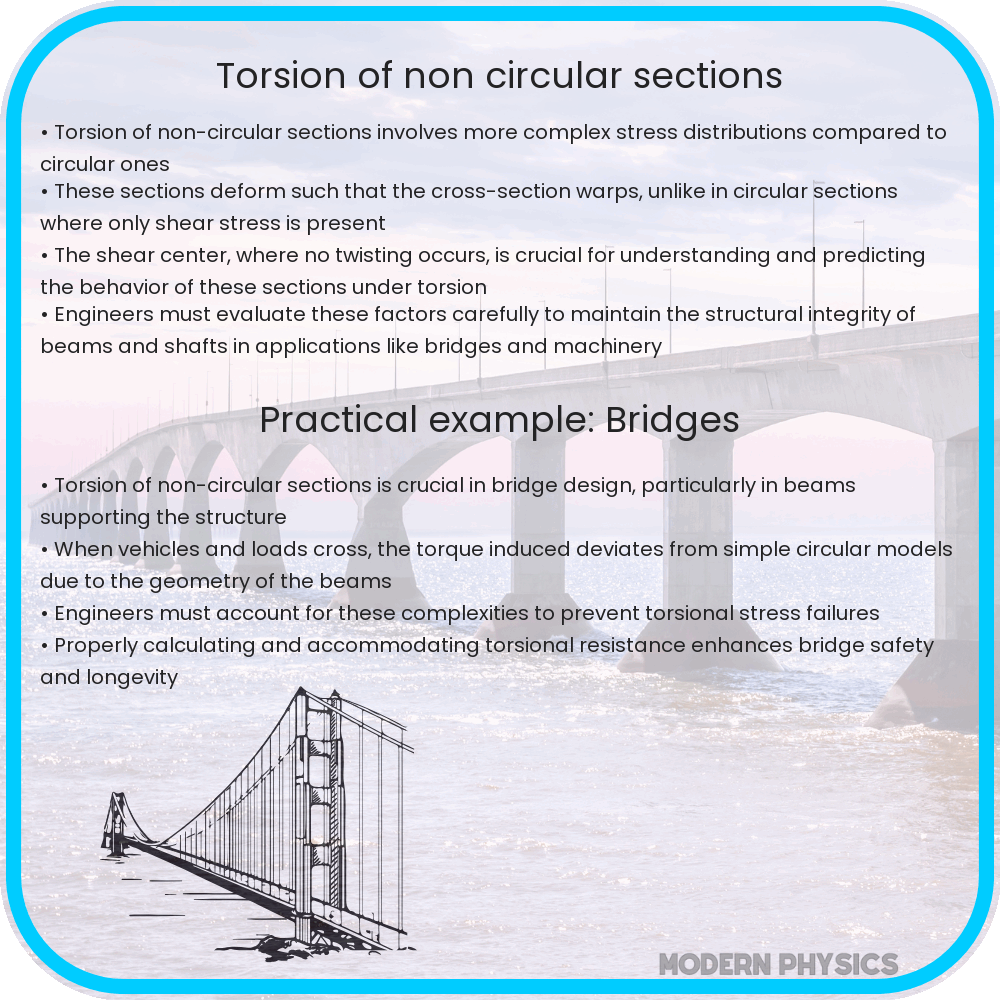Explore torsion in non-circular sections, covering shear stress distribution, advanced analysis techniques, material behavior, and design considerations.

Torsion of Non-Circular Sections in Mechanics and Design
The study of torsion in non-circular sections is a fundamental aspect of mechanics and design, particularly in the fields of structural engineering and materials science. Torsion refers to the twisting of an object due to an applied torque. Unlike circular sections, where the shear stress distribution is more uniform and predictable, non-circular sections present unique challenges due to their asymmetrical geometry.
Understanding Shear Stress in Non-Circular Sections
In non-circular sections, the distribution of shear stress is not uniform. The shear stress, denoted as τ, varies across the cross-section of the material. The maximum shear stress occurs at the outermost fibers of the material, farthest from the neutral axis. The formula for shear stress in a non-circular section can be expressed as:
τ = T*r/J
- T: Applied Torque
- r: Distance from the neutral axis to the point of interest
- J: Polar Moment of Inertia
For non-circular sections, the polar moment of inertia, J, is not straightforward to calculate as it depends on the specific geometry of the section. Common non-circular shapes include rectangles, I-beams, and L-shapes, each requiring a unique approach to determine J.
Stress Concentration in Non-Circular Sections
Non-circular sections are more prone to stress concentration, particularly at points where the geometry changes abruptly, such as corners or notches. Stress concentration can significantly weaken a structure if not properly accounted for in the design. Advanced computational methods, like finite element analysis (FEA), are often used to accurately model and predict these stress concentrations.
Applications in Design and Engineering
Understanding torsion in non-circular sections is crucial in various applications, including the design of shafts, beams, and other structural components in machinery and buildings. Engineers must consider the specific torsional properties of the materials and the geometric characteristics of the non-circular section to ensure safety and durability.
Material selection also plays a vital role. Different materials exhibit varied responses to torsional stress, with factors like yield strength, ductility, and modulus of elasticity influencing their performance under load.
Advanced Analysis Techniques for Non-Circular Sections
For a comprehensive understanding of torsion in non-circular sections, engineers often resort to advanced analytical and numerical methods. The warping function method, for instance, provides a means to calculate the stress distribution in irregular cross-sections. This method involves solving the governing differential equations of torsion for a given cross-section, which can be complex for non-circular shapes.
Numerical methods like Finite Element Analysis (FEA) have become indispensable in modern engineering. FEA allows for detailed modeling of complex geometries under various loading conditions, including torsion. It helps predict the behavior of non-circular sections more accurately, taking into account factors like material nonlinearity and geometric irregularities.
Material Behavior under Torsional Loading
Material behavior plays a crucial role in the response of non-circular sections to torsional loading. The relationship between shear stress and strain in a material determines how it will deform under torsional forces. Materials like steel, with a linear elastic behavior up to a certain point, followed by plastic deformation, exhibit different torsional characteristics than materials like rubber, which are highly elastic and exhibit non-linear stress-strain relationships.
Practical Considerations in Design
Practical considerations in the design of non-circular sections include the manufacturing process, cost, and intended application. For instance, while a certain shape might offer optimal torsional properties, it might be challenging or expensive to manufacture. Likewise, the intended application of the component may dictate specific material choices and geometric constraints.
Another critical factor is the consideration of dynamic loading scenarios, where the torsional load varies over time. This can lead to fatigue failure, a critical concern in rotating machinery and cyclically loaded structures.
Conclusion
Understanding torsion in non-circular sections is vital for the safe and efficient design of mechanical and structural components. It requires a careful consideration of material properties, geometric complexities, and loading conditions. Advanced analytical and numerical methods like the warping function method and FEA play a crucial role in accurately predicting the torsional behavior of these sections. Material selection, manufacturing processes, and practical application constraints are also essential factors in the design process. By integrating these considerations, engineers can ensure the reliability and longevity of components subjected to torsional stresses in various industrial and structural applications.
